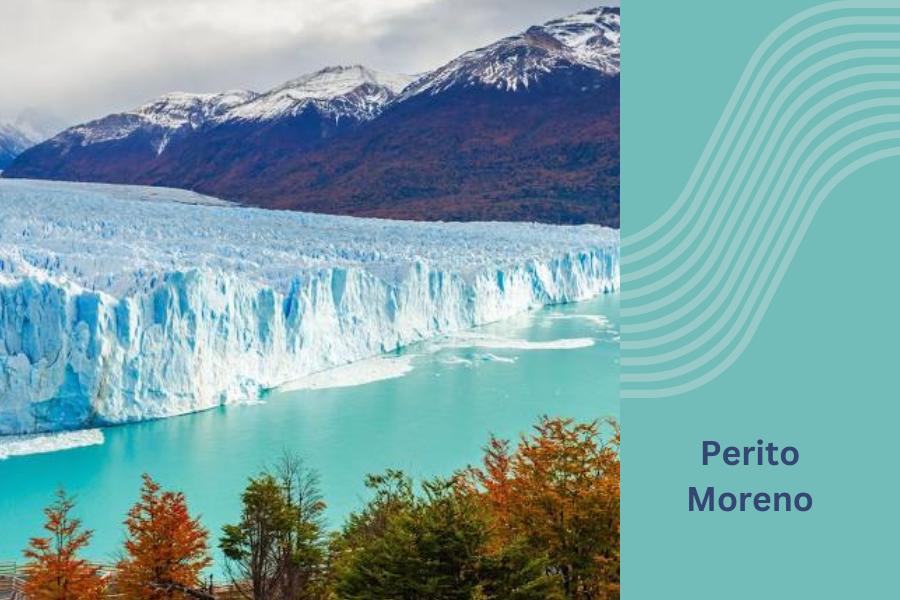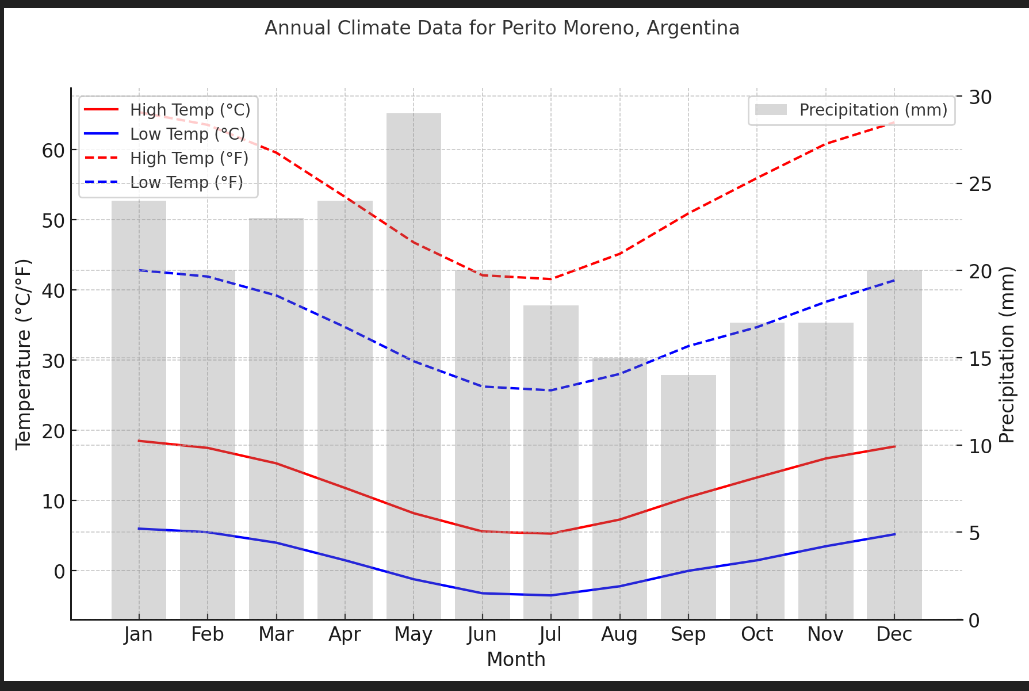
Perito Moreno, the ice colossus of Patagonia
Located in the far southwest of the province of Santa Cruz in Argentine Patagonia, the Perito Moreno Glacier is undoubtedly one of the country’s great natural monuments and one of the region’s most important tourist attractions. Part of the Los Glaciares National Park, a UNESCO World Heritage Site, this imposing river of ice with its huge walls of bluish ice and the spectacular calving of icebergs captivates thousands of visitors every year.
Gigantic proportions
The dimensions of Perito Moreno are truly overwhelming. With a length of 30 kilometers, a width of 5 kilometers and a thickness of 200 to 300 meters, it is one of the largest glaciers in the continental Patagonian ice field. Its front reaches an average height of 60 meters above sea level, with peaks up to 74 meters high, offering a majestic and impressive landscape.
A living glacier in constant motion Unlike most of the world’s glaciers, which are retreating rapidly due to global warming, Perito Moreno remains in balance thanks to its particular geographical location and behavior. This “alpine” glacier is fed by the ice of the Patagonian landscape and advances at a rate of about 2 meters per day, keeping its length stable.
The front of the Perito Moreno ends in a wall of compact ice that protrudes over the waters of the Brazo Rico of Lago Argentino. When this ice barrier reaches the point where the pressure on the opposite shore is greatest, huge ice floes break off, a phenomenon known as “wall break-off”. These break-offs occur cyclically every 4 to 5 years and create a unique spectacle with a deafening roar and the formation of large waves in the lake.
A thousand-year-old natural wonder
Despite its constant movement and renewal, glaciological studies have shown that the oldest bluish inland ice layers of Perito Moreno are estimated to be between 16,000 and 20,000 years old. This means that this enormous ice stream had its origins in the last Pleistocene glaciations.
The Perito Moreno is fed by the snow and ice fields of the Andes Mountains, in the area known as the Southern Patagonian Ice Sheet. The huge masses of ice that have accumulated over thousands of years due to the intense snowfalls in the Andes slowly flow eastwards in the form of glaciers and cross the valleys and lakes of the region.
A natural environment
Privileged In addition to the indescribable beauty of the glacier itself, the surroundings of Perito Moreno in Los Glaciares National Park offer a dreamlike natural landscape. The reserve protects around 30 large glaciers as well as countless glacier lagoons, primeval forests, Andean peaks and ice-formed valleys.
Notable glaciers include the 850 km2 Upsala, the 850 km2 Spegazzini, the front of which releases its water into Lago Argentino, and the Viedma, one of the largest glaciers in the region. The characteristic fauna includes the huemul, an endangered deer, guanacos, condors and rhinoceroses.
Access to the park is mainly via the nearby towns of El Calafate and El Chaltén. El Calafate is the starting point for cruises and trekking tours to the top of Perito Moreno, while El Chaltén is the starting point for trekking tours to the mythical mountain Fitz Roy and Cerro Torre.
Climate change: an uncertain future? Although the Perito Moreno is currently in relative equilibrium, glaciologists warn that its behavior could be drastically affected by global warming in the coming decades. A significant rise in temperature could lead to an accelerated and irreversible retreat of the ice masses.
For this reason, many believe that it is urgent to visit this incredible Patagonian natural monument before its physiognomy changes forever. Each cycle of detachment of the Perito Moreno Icefall could be more extraordinary than the last.
Whether walking on the surface, navigating between the detached icebergs or simply contemplating the magnificent wall of blue ice, the Perito Moreno Glacier undoubtedly offers a unique opportunity to get in touch with the imposing power of glacial nature. An experience you will hardly forget.
Excursions:
Frequently asked questions
Where is the Perito Moreno Glacier located?
The Perito Moreno Glacier is located in the Los Glaciares National Park in the province of Santa Cruz in the southwest of Argentina. It is about 80 km from the city of El Calafate.
What are the characteristics of the Perito Moreno Glacier?
- It is one of the most impressive and best-known glaciers in Argentinean Patagonia.
- It has a 5 km wide front and an average height of 60 meters above the water level.
- It is a glacier in constant motion and advance, fed by the South Patagonian Ice Field.
- It is known for its spectacular detachment of icebergs, a unique natural phenomenon.
How can I visit the Perito Moreno Glacier?
The main access is via footbridges and viewpoints in front of the glacier, from which you can admire its imposing front. There are also hikes on the glacier ice with specialized guides.
When is the best time to visit Perito Moreno?
The glacier can be visited all year round, but the most popular time is from October to April, when the temperatures are warmer and there are more hours of sunshine. In fall and winter there are fewer tourists, but the conditions are colder.
What other activities can I do near Perito Moreno?
Besides visiting the glacier, in and around El Calafate you can go on sailing trips on Lago Argentino, bird watching, hiking, horseback riding and other outdoor activities in Patagonia.
Map Perito Moreno

Annual climate table for Perito Moreno
| Month | Average High (°C) | Average Low (°C) | Average High (°F) | Average Low (°F) | Precipitation (mm) |
|---|---|---|---|---|---|
| January | 18.5 | 6.0 | 65.3 | 42.8 | 24 |
| February | 17.5 | 5.5 | 63.5 | 41.9 | 20 |
| March | 15.3 | 4.0 | 59.5 | 39.2 | 23 |
| April | 11.8 | 1.5 | 53.2 | 34.7 | 24 |
| May | 8.2 | -1.2 | 46.8 | 29.8 | 29 |
| June | 5.6 | -3.2 | 42.1 | 26.2 | 20 |
| July | 5.3 | -3.5 | 41.5 | 25.7 | 18 |
| August | 7.3 | -2.2 | 45.1 | 28.0 | 15 |
| September | 10.5 | 0.0 | 50.9 | 32.0 | 14 |
| October | 13.3 | 1.5 | 55.9 | 34.7 | 17 |
| November | 16.0 | 3.5 | 60.8 | 38.3 | 17 |
| December | 17.7 | 5.2 | 63.9 | 41.4 | 20 |

Source: perito-moreno.com
